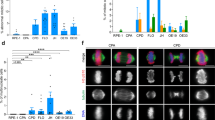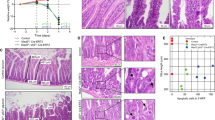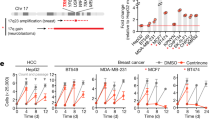Abstract
Mutations in the adenomatous polyposis coli (APC) tumour suppressor are the key initiating event of colorectal cancer. Although the control of WNT signalling is well established as a central tumour-suppressive function, the significance of APC in regulating chromosome instability is less well established. In this study, we test whether APC-deficient cells have a functional spindle assembly checkpoint (SAC) in vivo by examining the response of these cells to Taxol and Vinorelbine. We also show for the first time that APC deficiency compromises the arrest response to Taxol in vivo. This effect is independent of the role that APC has in WNT signalling. At higher levels of Taxol, APC-deficient cells arrest as efficiently as wild-type cells. Importantly, this dose of Taxol strongly suppresses intestinal tumourigenesis in models of benign (APCMin/+ mouse) and invasive (AhCreER+APCfl/+PTENfl/fl) cancer. In contrast to intestinal enterocytes with a general SAC defect because of Bub1 (budding uninhibited by benzimidazole 1) deletion, APC-deficient enterocytes arrest equivalently to wild type when treated with Vinorelbine. This suggests that the failed arrest in response to Taxol is because of a specific defect in microtubule stabilization following Taxol treatment rather than a general role of the APC protein in the mitotic spindle checkpoint. In summary, this study clarifies the role of APC as a mitotic spindle checkpoint protein in vivo and shows that APC-deficient cells have a compromised response to Taxol.
This is a preview of subscription content, access via your institution
Access options
Subscribe to this journal
Receive 50 print issues and online access
$259.00 per year
only $5.18 per issue
Buy this article
- Purchase on Springer Link
- Instant access to full article PDF
Prices may be subject to local taxes which are calculated during checkout





Similar content being viewed by others
References
Baena E, Gandarillas A, Vallespinos M, Zanet J, Bachs O, Redondo C et al. (2005). c-Myc regulates cell size and ploidy but is not essential for postnatal proliferation in liver. Proc Natl Acad Sci USA 102: 7286–7291.
Caldwell CM, Green RA, Kaplan KB . (2007). APC mutations lead to cytokinetic failures in vitro and tetraploid genotypes in Min mice. J Cell Biol 178: 1109–1120.
Dikovskaya D, Newton IP, Nathke IS . (2004). The adenomatous polyposis coli protein is required for the formation of robust spindles formed in CSF Xenopus extracts. Mol Biol Cell 15: 2978–2991.
Dikovskaya D, Schiffmann D, Newton IP, Oakley A, Kroboth K, Sansom O et al. (2007). Loss of APC induces polyploidy as a result of a combination of defects in mitosis and apoptosis. J Cell Biol 176: 183–195.
Dikovskaya D, Zumbrunn J, Penman GA, Nathke IS . (2001). The adenomatous polyposis coli protein: in the limelight out at the edge. Trends Cell Biol 11: 378–384.
Draviam VM, Shapiro I, Aldridge B, Sorger PK . (2006). Misorientation and reduced stretching of aligned sister kinetochores promote chromosome missegregation in EB1- or APC-depleted cells. EMBOJ 25: 2814–2827.
Fodde R, Kuipers J, Rosenberg C, Smits R, Kielman M, Gaspar C et al. (2001). Mutations in the APC tumour suppressor gene cause chromosomal instability. Nat Cell Biol 3: 433–438.
Gascoigne KE, Taylor SS . (2008). Cancer cells display profound intra- and interline variation following prolonged exposure to antimitotic drugs. Cancer Cell 14: 111–122.
Green RA, Wollman R, Kaplan KB . (2005). APC and EB1 function together in mitosis to regulate spindle dynamics and chromosome alignment. Mol Biol Cell 16: 4609–4622.
Gregorieff A, Pinto D, Begthel H, Destree O, Kielman M, Clevers H . (2005). Expression pattern of Wnt signaling components in the adult intestine. Gastroenterology 129: 626–638.
Huang HC, Shi J, Orth JD, Mitchison TJ . (2009). Evidence that mitotic exit is a better cancer therapeutic target than spindle assembly. Cancer Cell 16: 347–358.
Ireland H, Kemp R, Houghton C, Howard L, Clarke AR, Sansom OJ et al. (2004). Inducible Cre-mediated control of gene expression in the murine gastrointestinal tract: effect of loss of beta-catenin. Gastroenterology 126: 1236–1246.
Kaplan KB, Burds AA, Swedlow JR, Bekir SS, Sorger PK, Nathke IS . (2001). A role for the adenomatous polyposis coli protein in chromosome segregation. Nat Cell Biol 3: 429–432.
Kemp R, Ireland H, Clayton E, Houghton C, Howard L, Winton DJ . (2004). Elimination of background recombination: somatic induction of Cre by combined transcriptional regulation and hormone binding affinity. Nucleic Acids Res 32: e92.
Krikorian A, Breillout F . (1991). Vinorelbine (Navelbine). A new semisynthetic vinca alkaloid. Onkologie 14: 7–12.
Kroboth K, Newton IP, Kita K, Dikovskaya D, Zumbrunn J, Waterman-Storer CM et al. (2007). Lack of adenomatous polyposis coli protein correlates with a decrease in cell migration and overall changes in microtubule stability. Mol Biol Cell 18: 910–918.
Linn SC, Giaccone G . (1995). MDR1/P-glycoprotein expression in colorectal cancer. Eur J Cancer 31A: 1291–1294.
Marsh V, Winton DJ, Williams GT, Dubois N, Trumpp A, Sansom OJ et al. (2008). Epithelial Pten is dispensable for intestinal homeostasis but suppresses adenoma development and progression after Apc mutation. Nat Genet 40: 1436–1444.
Moser AR, Pitot HC, Dove WF . (1990). A dominant mutation that predisposes to multiple intestinal neoplasia in the mouse. Science 247: 322–324.
Nogales E, Whittaker M, Milligan RA, Downing KH . (1999). High-resolution model of the microtubule. Cell 96: 79–88.
Patel S, Doble BW, MacAulay K, Sinclair EM, Drucker DJ, Woodgett JR . (2008). Tissue-specific role of glycogen synthase kinase 3beta in glucose homeostasis and insulin action. Mol Cell Biol 28: 6314–6328.
Perera D, Tilston V, Hopwood JA, Barchi M, Boot-Handford RP, Taylor SS . (2007). Bub1 maintains centromeric cohesion by activation of the spindle checkpoint. Dev Cell 13: 566–579.
Radulescu S, Ridgway R, Taylor S, Sansom O . Bub1 haploinsufficiency cooperates with p53 loss to accelerate APC dependent intestinal tumourigenesis (in preparation).
Rusan NM, Peifer M . (2008). Original CIN: reviewing roles for APC in chromosome instability. J Cell Biol 181: 719–726.
Sansom OJ, Meniel VS, Muncan V, Phesse TJ, Wilkins JA, Reed KR et al. (2007). Myc deletion rescues Apc deficiency in the small intestine. Nature 446: 676–679.
Sansom OJ, Reed KR, Hayes AJ, Ireland H, Brinkmann H, Newton IP et al. (2004). Loss of Apc in vivo immediately perturbs Wnt signaling, differentiation, and migration. Genes Dev 18: 1385–1390.
Shibata H, Toyama K, Shioya H, Ito M, Hirota M, Hasegawa S et al. (1997). Rapid colorectal adenoma formation initiated by conditional targeting of the Apc gene. Science 278: 120–123.
Su LK, Burrell M, Hill DE, Gyuris J, Brent R, Wiltshire R et al. (1995). APC binds to the novel protein EB1. Cancer Res 55: 2972–2977.
Suzuki A, de la Pompa JL, Stambolic V, Elia AJ, Sasaki T, del Barco Barrantes I et al. (1998). High cancer susceptibility and embryonic lethality associated with mutation of the PTEN tumor suppressor gene in mice. Curr Biol 8: 1169–1178.
Suzuki A, Itami S, Ohishi M, Hamada K, Inoue T, Komazawa N et al. (2003). Keratinocyte-specific Pten deficiency results in epidermal hyperplasia, accelerated hair follicle morphogenesis and tumor formation. Cancer Res 63: 674–681.
Tighe A, Johnson VL, Taylor SS . (2004). Truncating APC mutations have dominant effects on proliferation, spindle checkpoint control, survival and chromosome stability. J Cell Sci 117: 6339–6353.
Uetake Y, Sluder G . (2004). Cell cycle progression after cleavage failure: mammalian somatic cells do not possess a ‘tetraploidy checkpoint’. J Cell Biol 165: 609–615.
Acknowledgements
This work was funded by the CR-UK project and programme grants to Inke Näthke and Owen Sansom. Sorina Radulescu was funded by an AICR grant. Help from Colin Nixon with histology and from Derek Miller and Tom Hamilton with transgenic work was much appreciated.
Author information
Authors and Affiliations
Corresponding author
Ethics declarations
Competing interests
The authors declare no conflict of interest.
Additional information
Supplementary Information accompanies the paper on the Oncogene website
Rights and permissions
About this article
Cite this article
Radulescu, S., Ridgway, R., Appleton, P. et al. Defining the role of APC in the mitotic spindle checkpoint in vivo: APC-deficient cells are resistant to Taxol. Oncogene 29, 6418–6427 (2010). https://doi.org/10.1038/onc.2010.373
Received:
Revised:
Accepted:
Published:
Issue Date:
DOI: https://doi.org/10.1038/onc.2010.373
Keywords
This article is cited by
-
Benchmark dose analyses of multiple genetic toxicity endpoints permit robust, cross-tissue comparisons of MutaMouse responses to orally delivered benzo[a]pyrene
Archives of Toxicology (2018)
-
Cell-cycle synchronization reverses Taxol resistance of human ovarian cancer cell lines
Cancer Cell International (2013)



